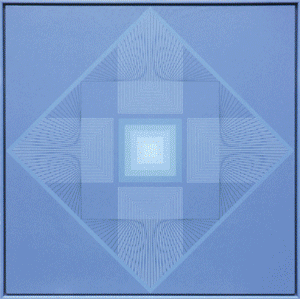- Transmission Difficulties
- Vancouver Painting in the 1960s
- A painting is a pitiable thing . . .
- The experience of a work of art . . .
- A painting is mediumistic . . .
- By Scott Watson
3.
An essay like this, focused on painting, is a priori arbitrary. Painting in the sixties can only be isolated as a practice in exceptional circumstances. The break between one artistic (and cultural) episteme and another that took place in the sixties was dramatic in the field of painting, if such a field - uncontaminated by other practices - could even be said to exist. Perhaps it was the introduction of acrylic paint that led to the fascination with plexiglass and plastic as media. As an example of the increasing vagueness of the category, Iain Baxter's Bagged Landscape, inflatable plastic constructions, were regularly classified as paintings. The attrition rate for painters was high, especially in Vancouver, where the scene's volatility must have had something to do with the very "remoteness" and small scale of its "scene with no scene." That is, the lack of a non-institutional market for contemporary Canadian art accelerated the collapse of painting, which was simply becoming less and less viable. It became especially impractical to produce the large-scale canvases that signaled ambition, as there was never a market for them. Those who painted struggled with the very idea of painting, which was called into question by an increasingly official "avant-garde." Many painters whose debuts as young people in mid-decade had seemed to promise such brilliance stopped painting before the decade was out. Some of them left art altogether. Even today, despite persistent attention to the decade that marks the divide between the modern and the postmodern, interest in the painting production of the sixties remains dormant.
But . . . something else was being advanced . . .
An essay like this, focused on painting, is a priori arbitrary. Painting in the sixties can only be isolated as a practice in exceptional circumstances. The break between one artistic (and cultural) episteme and another that took place in the sixties was dramatic in the field of painting, if such a field - uncontaminated by other practices - could even be said to exist. Perhaps it was the introduction of acrylic paint that led to the fascination with plexiglass and plastic as media. As an example of the increasing vagueness of the category, Iain Baxter's Bagged Landscape, inflatable plastic constructions, were regularly classified as paintings. The attrition rate for painters was high, especially in Vancouver, where the scene's volatility must have had something to do with the very "remoteness" and small scale of its "scene with no scene." That is, the lack of a non-institutional market for contemporary Canadian art accelerated the collapse of painting, which was simply becoming less and less viable. It became especially impractical to produce the large-scale canvases that signaled ambition, as there was never a market for them. Those who painted struggled with the very idea of painting, which was called into question by an increasingly official "avant-garde." Many painters whose debuts as young people in mid-decade had seemed to promise such brilliance stopped painting before the decade was out. Some of them left art altogether. Even today, despite persistent attention to the decade that marks the divide between the modern and the postmodern, interest in the painting production of the sixties remains dormant.
But . . . something else was being advanced . . .

